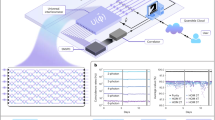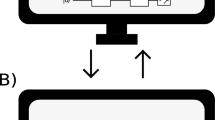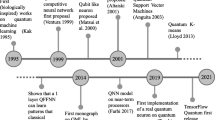Abstract
Photonic quantum computing is a leading approach toward universal quantum computation. Here, we propose a realistic model for the implementation of neural networks on photonic quantum computers. Specially, we design a quantum circuit built in the continuous-variable (CV) architecture that encodes information in the spectral amplitude functions of single-photons. This circuit consisting of some electro-optical modulators and XOR boxes that, respectively, adjust and combine their entries to provide a weighted sum of input signals. We show that our model can reproduce classical neural network models while maintaining some quantum phenomena such as superposition and entanglement. In particular, we utilize the circuit as a quantum classifier and validate the CV quantum neural network architecture through doing some machine learning modeling experiments. Such a quantum circuit can be implemented on the CV photonic quantum computers that promise exponential speed-up over the classical computers for specific tasks.







Similar content being viewed by others
Data Availability
The datasets generated during and/or analyzed during the current study are available from the corresponding author on reasonable request.
References
Killoran, N., Bromley, T.R., Arrazola, J.M., Schuld, M., Quesada, N., Lloyd, S.: Continuous-variable quantum neural networks. Phys. Rev. Res. 1, 033063 (2019)
Phillipson, F.: tQANSWER, pp. 51–56 (2020)
Perdomo-Ortiz, A., Benedetti, M., Realpe-Gómez, J., Biswas, R.: Opportunities and challenges for quantum-assisted machine learning in near-term quantum computers. Quantum Sci. Technol. 3, 030502 (2018)
Benedetti, M., Realpe-Gómez, J., Perdomo-Ortiz, A.: Quantum-assisted Helmholtz machines: a quantum-classical deep learning framework for industrial datasets in near-term devices. Quantum Sci. Technol. 3, 034007 (2018)
Gottesman, D., Kitaev, A., Preskill, J.: Encoding a qubit in an oscillator. Phys. Rev. A 64, 012310 (2001)
Giovannetti, V., Lloyd, S., Maccone, L.: Quantum random access memory. Phys. Rev. Lett. 100, 160501 (2008)
Barenco, A., Bennett, C.H., Cleve, R., DiVincenzo, D.P., Margolus, N., Shor, P., Sleator, T., Smolin, J.A., Weinfurter, H.: Elementary gates for quantum computation. Phys. Rev. A 52, 3457 (1995)
Plesch, M., Brukner, Č: Quantum-state preparation with universal gate decompositions. Phys. Rev. A 83, 032302 (2011)
Kumar, P.: Direct implementation of an N-qubit controlled-unitary gate in a single step. Quantum Inf. Process. 12, 1201 (2013)
Knill, E., Laflamme, R., Milburn, G.J.: A scheme for efficient quantum computation with linear optics. Nature 409, 46 (2001)
Kok, P., Lovett, B.W.: Introduction to Optical Quantum Information Processing. Cambridge University Press, Cambridge (2010)
Rohde, P.P., Fitzsimons, J.F., Gilchrist, A.: Information capacity of a single photon. Phys. Rev. A 88, 022310 (2013)
Menicucci, N.C., Van Loock, P., Gu, M., Weedbrook, C., Ralph, T.C., Nielsen, M.A.: Universal quantum computation with continuous-variable cluster states. Phys. Rev. Lett. 97, 110501 (2006)
Wang, X.-B., Hiroshima, T., Tomita, A., Hayashi, M.: Quantum information with Gaussian states. Phys. Rep. 448, 1 (2007)
Jozsa, R., Linden, N.: On the role of entanglement in quantum-computational speed-up. Proc. R. Soc. Lond. Ser. A Math. Phys. Eng. Sci. 459, 2011 (2003)
Lloyd, S., Mohseni, M., Rebentrost, P. (2013). arXiv preprint arXiv:1307.0411
Cai, X.-D., Wu, D., Su, Z.-E., Chen, M.-C., Wang, X.-L., Li, L., Liu, N.-L., Lu, C.-Y., Pan, J.-W.: Entanglement-based machine learning on a quantum computer. Phys. Rev. Lett. 114, 110504 (2015)
Cao, Y., Guerreschi, G.G., Aspuru-Guzik, A. (2017). arXiv preprint arXiv:1711.11240
Schuld, M., Bocharov, A., Svore, K.M., Wiebe, N.: Circuit-centric quantum classifiers. Phys. Rev. A 101, 032308 (2020)
Benedetti, M., Grant, E., Wossnig, L., Severini, S.: Adversarial quantum circuit learning for pure state approximation. New J. Phys. 21, 043023 (2019)
Preskill, J.: Quantum computing in the NISQ era and beyond. Quantum 2, 79 (2018)
Hur, T., Kim, L., Park, D.K.: Quantum convolutional neural network for classical data classification. Quantum Mach. Intell. 4, 1 (2022)
Belsley, D.A., Kuh, E., Welsch, R.E.: Regression Diagnostics: Identifying Influential Data and Sources of Collinearity, vol. 571. Wiley, Hoboken (2005)
Schuld, M., Killoran, N.: Quantum machine learning in feature Hilbert spaces. Phys. Rev. Lett. 122, 040504 (2019)
Havlíček, V., Córcoles, A.D., Temme, K., Harrow, A.W., Kandala, A., Chow, J.M., Gambetta, J.M.: Supervised learning with quantum-enhanced feature spaces. Nature 567, 209 (2019)
Liu, H.-L., Yu, C.-H., Wu, Y.-S., Pan, S.-J., Qin, S.-J., Gao, F., Wen, Q.-Y. (2019). arXiv preprint arXiv:1906.03834
Harrison, D., Jr., Rubinfeld, D.L.: Hedonic housing prices and the demand for clean air. J. Environ. Econ. Manag. 5, 81 (1978)
Shadbolt, P.J., Verde, M.R., Peruzzo, A., Politi, A., Laing, A., Lobino, M., Matthews, J.C., Thompson, M.G., O’Brien, J.L.: Generating, manipulating and measuring entanglement and mixture with a reconfigurable photonic circuit. Nat. Photon. 6, 45 (2012)
McGuinness, H.J., Raymer, M.G., McKinstrie, C.J., Radic, S.: Quantum frequency translation of single-photon states in a photonic crystal fiber. Phys. Rev. Lett. 105, 093604 (2010)
Sinclair, N., Saglamyurek, E., Mallahzadeh, H., Slater, J.A., George, M., Ricken, R., Hedges, M.P., Oblak, D., Simon, C., Sohler, W., et al.: Spectral multiplexing for scalable quantum photonics using an atomic frequency comb quantum memory and feed-forward control. Phys. Rev. Lett. 113, 053603 (2014)
Wright, L.J., Karpiński, M., Söller, C., Smith, B.J.: Spectral shearing of quantum light pulses by electro-optic phase modulation. Phys. Rev. Lett. 118, 023601 (2017)
Fan, L., Zou, C.-L., Poot, M., Cheng, R., Guo, X., Han, X., Tang, H.X. (2016). arXiv preprint arXiv:1607.01823
Braunstein, S.L.: Quantum Information with Continuous Variables, pp. 19–29. Springer, Berlin (1998)
Yoshikawa, J.-I., Miwa, Y., Huck, A., Andersen, U.L., Van Loock, P., Furusawa, A.: Demonstration of a quantum nondemolition sum gate. Phys. Rev. Lett. 101, 250501 (2008)
McCulloch, W.S., Pitts, W.: A logical calculus of the ideas immanent in nervous activity. Bull. Math. Biophys. 5, 115 (1943)
Rabinovich, M.I., Varona, P., Selverston, A.I., Abarbanel, H.D.: Dynamical principles in neuroscience. Rev. Mod. Phys. 78, 1213 (2006)
MacKay, D.J., Mac Kay, D.J. (2003)
Glatzel, T., Sadewasser, S., Lux-Steiner, M.C.: Amplitude or frequency modulation-detection in Kelvin probe force microscopy. Appl. Surf. Sci. 210, 84 (2003)
Horowitz, P., Hill, W., Robinson, I.: The Art of Electronics, vol. 2. Cambridge University Press, Cambridge (1989)
Ghahderijani, M.M., Castilla, M., Momeneh, A., Miret, J.T., de Vicuna, L.G.: Frequency-modulation control of a DC/DC current-source parallel-resonant converter. IEEE Trans. Ind. Electron. 64, 5392 (2017)
Zippilli, S., Di Giuseppe, G., Vitali, D.: Entanglement and squeezing of continuous-wave stationary light. New J. Phys. 17, 043025 (2015)
Rohde, P.P., Mauerer, W., Silberhorn, C.: Spectral structure and decompositions of optical states, and their applications. New J. Phys. 9, 91 (2007)
Branning, D., Grice, W., Erdmann, R., Walmsley, I.: Interferometric technique for engineering indistinguishability and entanglement of photon pairs. Phys. Rev. A 62, 013814 (2000)
Grice, W.P., U’Ren, A.B., Walmsley, I.A.: Eliminating frequency and space–time correlations in multiphoton states. Phys. Rev. A 64, 063815 (2001)
Wang, J., Sciarrino, F., Laing, A., Thompson, M.G.: Integrated photonic quantum technologies. Nat. Photon. 14, 273 (2020)
Pati, A.K., Braunstein, S.L.: Quantum Information with Continuous Variables, pp. 31–36. Springer, Berlin (2003)
Author information
Authors and Affiliations
Contributions
E. Gh was responsible for the inception of the project. E. Gh, H. R and A. R contributed to its ongoing design and development.
Corresponding author
Ethics declarations
Conflict of interest
The authors declare that there are no competing interests.
Additional information
Publisher's Note
Springer Nature remains neutral with regard to jurisdictional claims in published maps and institutional affiliations.
Supplementary
Supplementary
1.1 Single-photon states
A single-photon can be introduced via a superposition of different spectral components, to encode an N-level qudit, where N can generally be arbitrarily large. Performing such encoding requires a set of spectral functions \(\{\Psi _i(\omega )\}\), where \(\omega \) is the frequency relative to a central carrier frequency [12].
Since the photonic spectral degree of freedom is continuous, in principle infinite information could be encoded and transmitted by a single-photon state. However, the communicable information is reduced subject to realistic channel, detector, and photon engineering constraints. Ideally, orthonormal basis, \(\int _{-\infty }^{+\infty } {\textrm{d}}\omega \Psi _i(\omega )\Psi _i^*(\omega )=\delta _{ij}\) would be of interest, since they can always be perfectly distinguished with an appropriate measurement device. Nevertheless, in reality, such orthogonality may only be achieved approximately. Figure 8 shows a specific Gaussian spectral basis with the same variance centered at different frequencies. Assuming the Gaussian distributions with zero variance, one could achieve orthonormality. However, this would be physically unrealistic. Photonic mode operators can be defined as \({\hat{A}}_{\Psi (\omega )}^\dagger = \int _{-\infty }^{+\infty } {\textrm{d}}\omega \Psi (\omega ){\hat{a}}^\dagger (\omega )\), which create photons with a well-defined spectral distribution function \(\Psi (\omega )\), where \({\hat{a}}^\dagger \) is the single-frequency photonic creation operator in the spatial mode a [42]. A single-photonic state can be obtained as \({\hat{A}}_{\Psi (\omega )}^\dagger |0\rangle \) where \(|0\rangle \) is the vacuum state. Accordingly, a spectral basis state may be expressed as \(\rho (\omega )={\hat{A}}_{\Psi (\omega )}^\dagger |0\rangle \langle 0| {\hat{A}}_{\Psi (\omega )}\).
In principle, there are various basis \(\{\Psi _i(\omega )\}\) such as frequency or temporal delta functions, wavelet families, Hermite polynomials, or any other set of functions satisfying orthonormality [12]. However, not all states can be readily engineered for quantum information and quantum computation [43,44,45].
1.2 A quantum neuron with three input signals
For the sake of simplicity, we consider a simple circuit with three input signals as shown in Fig. 9. The initial state vector of the circuit reads as,
where,
At first, the signals enter the modulators that shift their central frequencies. The action of the modulator on the central frequency of each single-photon may be obtained as,
where \(\eta _i \in {\mathbb {R}}\) is a parameter that must be controlled (and updated) during the training process of the neural network. Now, we wish to establish a superposition of photonic states. Another useful unitary gate on a CV quantum computer is the XOR gate [46]. Each XOR concatenates its input signals, i.e., the two frequency-shifted single-photon states. Thus, the spectral amplitude function corresponding to the output of the first XOR can be written as,
which implies that the spectral amplitudes of the output signals are entangled after passing through the XOR gate. In other words, the two single-photon states become entangled by the action of the XOR gate. Entanglement is a quantum phenomenon that has no classical counterpart and plays a key role in quantum computation.
Next, we consider the third qumode and try to find the output of the second XOR gate. Again, the XOR concatenates its photonic qumodes, therefore, the corresponding output qumode can be introduced by the following spectral amplitude function,
Therefore, the output state of the circuit can be obtained as,
where \(M({\varvec{\eta }})\) denotes the modulators. This is an entangled state vector because the respective spectral amplitude function cannot be separated as below,
From Eq. (19), one can obtain the density operator of the output of the circuit as,
Using Eq. (18), the density operator can be rewritten as,
Now, we want to focus on the last qumode of the output state of the circuit, hence, we proceed to remove the other unwanted qumodes. To do this, we trace out the first and second qumodes as below,
which can be simplified as,
where we have used the relation \(\langle 0|_i {\hat{a}} (\omega '_i) {\hat{a}}^\dagger (\omega _j) |0\rangle _j=\langle {1_i\Vert 1_j}\rangle =\delta _{i,j}\) for \(i,j=1,2\). Note that \(|1_i\rangle \) denotes the state of a single-photon in the i-th mode. The states of two single-photons corresponding to different modes are orthogonal, i.e., \(\langle {1_k\Vert 1_l}\rangle =\delta _{k,l}\) (\(k \ne l\)), while for the same modes we have \(\langle {1_k\Vert 1_k}\rangle =1\) (\(k,l=1,2,3\)).
Now, let us check the normalization of the density operator of the output signal as below,
which can be simplified as,
by computing the Gaussian integrals, one can readily show that \({{\textrm{Tr}}}(\rho _{3})=1\).
It is worth to note that the bias can be added by considering an additional photonic state, i.e., the zero-th qumode with \(b=\eta _0\) and a Gaussian distribution centered at \({\bar{\omega }}_0=1\). Therefore, we can replace \(\sum _{i=1}^{3} \eta _i {\bar{\omega }}_i\) by \(b+\sum _{i=1}^{3} \eta _i {\bar{\omega }}_i=\sum _{i=0}^{3} \eta _i {\bar{\omega }}_i\) in Eq. (25).
The diagonal elements of the density operator, which can be obtained via the ideal homodyne measurement, provide the probabilities of reading the frequency \(\omega \) of the third qumode,
which can be simplified as,
where \(\Delta ^2= 4\sigma _1^2+\sigma _2^2+\sigma _3^2\). The above relation is a normal Gaussian distribution which implies that,
Now, we know the probability distribution of the outcome of the circuit which can be used for quantum machine learning. The most probable outcome of the circuit can be obtained as,
Consequently, a sequence of Gaussian gates, i.e., modulators and XORs followed by homodyne measurement as a non-Gaussian operation, lead to the desired transformation \(|1,\phi (\omega _1)\rangle \otimes |1,\phi (\omega _2)\rangle \otimes |1,\phi (\omega _3)\rangle \rightarrow P(\omega ) \rightarrow \omega _m\). This transformation recalls a single-layer classical neural network. Note that the outcome of the circuit can be used in different ways based on the defined goals. Here, we use the most probable outcome of the circuit for the binary classification tasks. As mentioned, Eq. (28) is a normal Gaussian distribution which implies that one can use this for other classification tasks dealing with Gaussian samples.
Rights and permissions
Springer Nature or its licensor (e.g. a society or other partner) holds exclusive rights to this article under a publishing agreement with the author(s) or other rightsholder(s); author self-archiving of the accepted manuscript version of this article is solely governed by the terms of such publishing agreement and applicable law.
About this article
Cite this article
Ghasemian, E., Razminia, A. & Rostami, H. Quantum machine learning based on continuous variable single-photon states: an elementary foundation for quantum neural networks. Quantum Inf Process 22, 378 (2023). https://doi.org/10.1007/s11128-023-04137-4
Received:
Accepted:
Published:
DOI: https://doi.org/10.1007/s11128-023-04137-4






